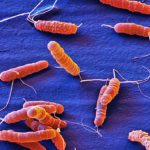Lien vers Pubmed [PMID] – 16173497
Int. J. Med. Microbiol. 2005 Sep;295(5):307-15
Urease, a nickel metalloenzyme is an essential virulence factor of the gastric pathogen, Helicobacter pylori. This enzyme is the major actor in the resistance to acidity and, therefore, plays a central role in colonization and persistence in the host. Urease has till recently been considered to be a constitutive and permanently active enzyme. Recent advances have revealed that the activity of this abundant protein is subtly modulated at different levels. These regulatory mechanisms mainly concern nickel insertion at the urease active site with control of both the availability and incorporation of this metal ion into the structural subunits, whose production itself is induced in some conditions. Another level of regulation is the availability of the urease substrate, urea, which is controlled by UreI, an acid-gated urea channel encoded by the urease gene cluster. We calculated that under in vitro conditions without added nickel only a small proportion of the urease active sites is filled with nickel but that this is sufficient for full acid resistance. This raised the question of why this organism produces this enzyme far in excess of its needs. We propose a model in which the role of excess urease is to maintain a pool of actively bound intracellular Ni2+ ions which can be inherited by the daughter cells to provide sufficient activated urease even in case of long-term nickel deficiency.

